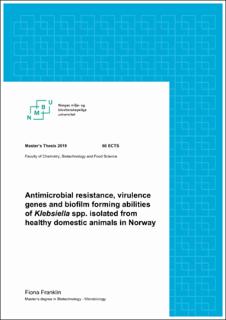| dc.contributor.advisor | Sunde, Marianne | |
| dc.contributor.advisor | Telke, Amar Anandrao | |
| dc.contributor.advisor | Lindstedt, Bjørn-Arne | |
| dc.contributor.author | Franklin, Fiona | |
| dc.date.accessioned | 2020-02-18T13:19:33Z | |
| dc.date.available | 2020-02-18T13:19:33Z | |
| dc.date.issued | 2019 | |
| dc.identifier.uri | https://hdl.handle.net/11250/2642328 | |
| dc.description.abstract | Klebsiella can be identified in several different environmental habitats, animals and humans. There are many different species and subspecies of Klebsiella, with Klebsiella pneumoniae being the most medically important species within this genus and is an important cause of hospital-acquired infection (nosocomial infection). Klebsiella is part of the “ESKAPE pathogens”, which is an acronym used for the six most common nosocomial pathogens; Enterococcus faecium, Staphylococcus aureus, Klebsiella pneumoniae, Acinetobacter baumannii, Pseudomonas aeruginosa and Enterobacter species. Most of these bacteria are also opportunistic and could pose a severe threat to patients, especially if they were to become increasingly resistant to antimicrobial agents.
A total of 1290 faecal samples from turkey, swine, broiler, dog and cattle (supplied by NORM-VET) were screened to identify Klebsiella spp. From these samples 380 (29.46%) were identified positive for Klebsiella spp. Turkey had en overall detection rate of 69.57%, swine 51.79%, broiler 23.51%, dog 15.87% and 4.56% in cattle.
Three different isolation methods for Klebsiella spp. were tested on a subset of the samples (n= 343 originating from swine and cattle) with the results indicating that the Klebsiella spp. detection rate was higher in samples enriched in LB broth with 10mg/l amoxicillin (45.52% [95% CI: 38-55]), compared to direct out plating (19.53% [95% CI: 15-24%]) and peptone water enrichment (25.56% [95% CI: 21- 30%]).
All the 380 Klebsiella isolates found were screened for antimicrobial resistance, by being subjected to susceptibility testing that resulted in 7.38% expressing resistance against one or more antimicrobial agent. The prevalence of resistant strains originating from turkey was 60.71%, from broiler 21.43% and from both dog and swine 7.14%. While no resistance was indicated in isolates originating from cattle.
The whole genome sequencing data of the 203 poultry isolates, revealed that 22.66% of the isolates encoded for one or more virulence genes. Yersiniabactin (ybt) was identified in 21.18% of the isolates, aerobactin (iuc5) in 7.88%, and salmochelin (iro5) in 7.39% isolates. All the isolates encoding for salmochelin also encoded for aerobaction, with the detection of IcFII plasmid carrying virulence genes.
There were 64 different sequence types identified among the 203 K. pneumonia isolates from poultry. ST35 was identified in 14.29%, followed by ST290-1LV with 7.39%. These sequence types have also been detected in humans.
The average biofilm production for K. pneumoniae was OD595 0.66 (STDEV: 0.52-0.80), indicating that they are good producers.
In conclusion, the overall antimicrobial resistance occurrence among Klebsiella spp. from Norwegian domestic animals was low. Among the resistant isolates resistance against tetracycline and sulfamethoxazole was most commonly observed. Virulence genes encoding, yersiniabactin, salmochelin and aerobactin, were detected in some of the isolates, with salmochelin and aerobactin encoding genes located on incF plasmids. Further analysis would be recommended in regards to ST290 and ST290-1LV and the detected virulence genes. | en_US |
| dc.description.abstract | Klebsiella kan identifiseres i flere ulike miljøer, dyr og mennesker. Det er mange arter og under arter av Klebsiella, og deriblant er Klebsiella pneumoniae ansett å være den medisinsk viktigste arten, da den ofte forårsaker sykehuservervede infeksjoner. Klebsiella er en del av gruppen ESKAPE patogener, som omslutter de seks mest vanlige sykehuservervede patogene; Enterococcus faecium, Staphylococcus aureus, Klebsiella pneumoniae, Acinetobacter baumannii, Pseudomonas aeruginosa and Enterobacter species. Mesteparten av disse bakteriene er opportunistiske og kan bli en trussel mot sykehus pasienter, særlig om de utvikler bred antimikrobiell resistens. | en_US |
| dc.description.sponsorship | KLEB-GAP project ; NoResist project ; Norwegian Veterinary
Institute | en_US |
| dc.language.iso | eng | en_US |
| dc.publisher | Norwegian University of Life Sciences, Ås | en_US |
| dc.rights | Attribution-NonCommercial-NoDerivatives 4.0 Internasjonal | * |
| dc.rights.uri | http://creativecommons.org/licenses/by-nc-nd/4.0/deed.no | * |
| dc.subject | Klebsiella | en_US |
| dc.subject | Klebsiella pneumoniae | en_US |
| dc.subject | Antimicrobial resistance | en_US |
| dc.subject | Virulence | en_US |
| dc.subject | Biofilm | en_US |
| dc.title | Antimicrobial resistance, virulence genes and biofilm forming abilities of Klebsiella spp. isolated from healthy domestic animals in Norway | en_US |
| dc.title.alternative | Antimikrobiell resistens, virulensgener og biofilmdannende evner til Klebsiella spp. isolert fra friske husdyr i Norge | en_US |
| dc.type | Master thesis | en_US |
| dc.description.version | submittedVersion | en_US |
| dc.rights.holder | Veterinærinstituttet, Oslo og KLEB-GAP | en_US |
| dc.source.pagenumber | 135 | en_US |

